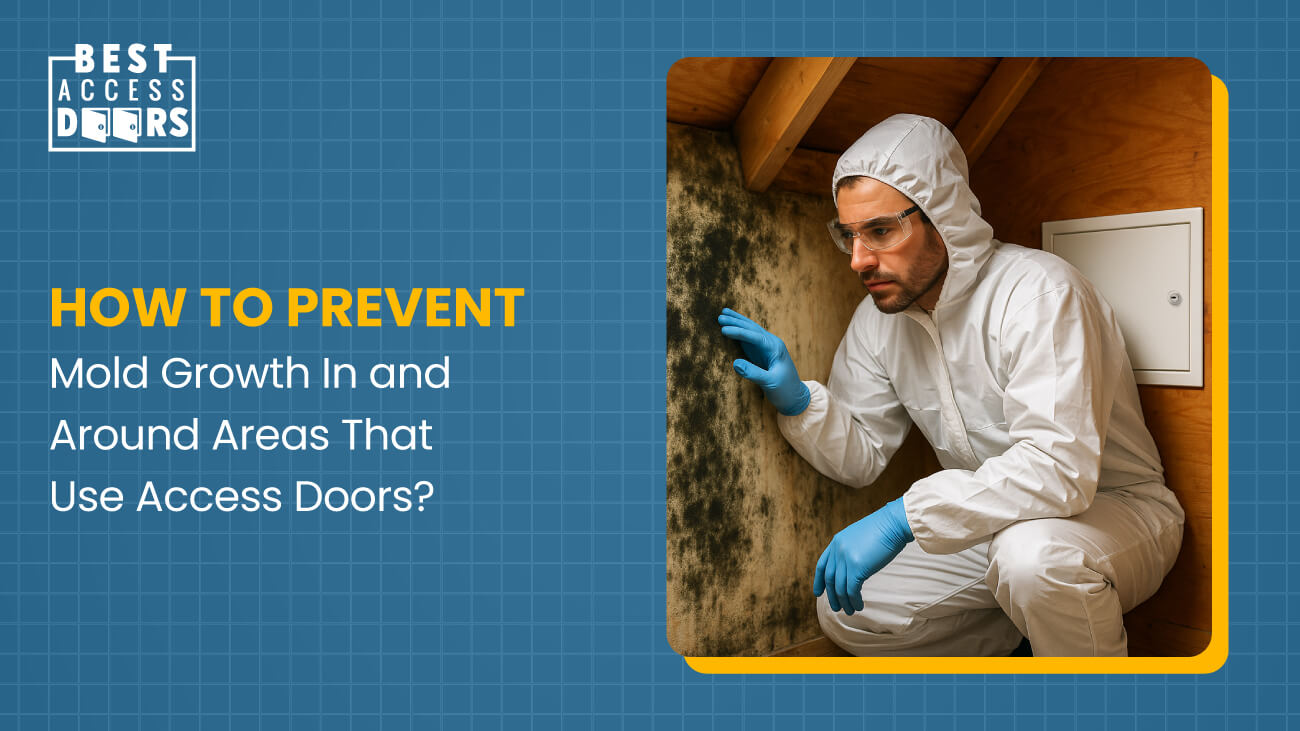How To Prevent Mold Growth In and Around Areas That Use Access Doors
Posted by Best Access Doors on 18th Jul 2025
The non-living spaces we typically cover with access panels are unfortunately often prone to mold. This includes attics, crawl spaces, under-stairs storage areas, water shutoff valve cupboards, and more.
So, how do you prevent mold from growing in these hidden-away spaces – and what do you do if you do find mold there? The mold removal experts at Cleaner Guys have distilled down some quick answers for us, from their decades of experience with mold.
Why Mold Grows In Areas That Benefit from Access Doors
Why would mold be more common in spaces like attics and crawl spaces? There are a couple of reasons.
First, such spaces are typically excluded from the home’s heating and air conditioning. They are also often not as thoroughly insulated as the rest of the home. This leads to a large difference in temperature between these non-living spaces and the rest of the home.
This temperature difference can cause condensation and high humidity in the access door space, and that excess moisture causes mold growth. Mold only grows where there’s moisture, and it prefers darkness, so a dark space with lots of condensation is perfect for mold.
Another common cause of mold is rodent intrusion, typically in attics and crawl spaces. The holes they create when they chew and burrow in your home let in water, which introduces a damp environment perfect for mold. Rodent excretions also feed mold, allowing it to spread even more.
How to Prevent Mold Growth in Areas Behind an Access Door
Now that you have a better understanding of why mold is common in access door spaces, we can address practical ways to prevent it before it starts. Here are Cleaner Guys’ top recommendations for keeping your access door spaces mold-free.
1. Set quarterly reminders on your calendar to inspect your access door spaces for moisture and rodent intrusion, and mold.
The best way you can prevent mold is to check for it regularly. The longer mold has to grow, the worse it’ll get. You want to catch it early, and the best way to do that is to check often, or pay someone to.
2. Maintain good sealing and rodent barriers in access door spaces.
Ventilation holes are necessary in attics and crawl spaces in order to maintain good air circulation, but they are also the most common rodent access point. Ensure that these ventilation holes have properly-installed rodent barries over them, and when one is broken or loose, replace it right away. Ensure also that your access door spaces are well sealed from water intrusion by getting annual roof and crawl space inspections.
3. Keep humidity low and ventilation high.
This tip is important both for access door spaces, and for the whole home! High humidity and stagnant air promote mold growth, so you should maintain low humidity and good air circulation everywhere. Keeping your indoor humidity below 50% is a good marker, according to the EPA. Keep the air in your home circulating by regularly using AC or fans, or by opening windows.
4. Elevate and weatherproof outdoor access doors, such as for crawlspaces.
Having an elevated, well-sealed barrier that keeps your outdoor access doors off the ground is the best way to prevent outside water intrusion. If an outdoor access door is sitting level with the ground, water pools on top of it and, over time, it will leak in.
Why Preventing Mold Growth Is Important
While many people think of mold as not a big deal, it’s actually very serious. Mold causes mold sickness, the symptoms of which can include endless headaches, poor sleep, and cold or allergy symptoms like coughing and post-nasal drip.
For those with respiratory illnesses like asthma, and for the immunocompromised – such as infants and the elderly – symptoms can be far more severe. Prolonged mold exposure has even been linked to poor mental health and neurodegenerative diseases like Alzheimer’s Disease.
Mold also spreads its roots deep into the wood and drywall it grows on, which weakens the structural integrity of your home!
If you do find mold in your home, the best thing you can do is call a professional mold remediation company. Almost all of the time, layman attempts to remove mold are not successful.
How Having High-Quality Access Doors Matters for Preventing Mold in Non-Living Spaces
We’ve heavily emphasized the importance of regularly inspecting your access door spaces for moisture and rodent intrusion and proper sealing, to prevent mold. But having good, high-quality access doors makes a huge difference in how easy it is for you or a professional to inspect those spaces!
Old, worn, poor-quality, or nonexistent access doors can make regular inspection of these spaces and the appliances in them – such as water heaters, sump pumps, and HVAC systems – much more difficult, and even impossible!
Having high-quality access doors also helps prevent damage to your home, in more ways than one! Old or poor-quality access door can let in moisture, which promotes mold growth.
Additionally, nonexistent or damaged access doors can make it easy for children to access something that you don’t want them having access to. Children tampering with the wrong valve, device, or non-living space could cause water damage, electrocution, exposure to hazards, and more!
Having a good, high-quality access door over all the important non-living spaces in your home is your best bet for preventing all kinds of damage and catastrophe. Don’t skip it!
Share our story - the 2025 version is available

 Feedback
Feedback